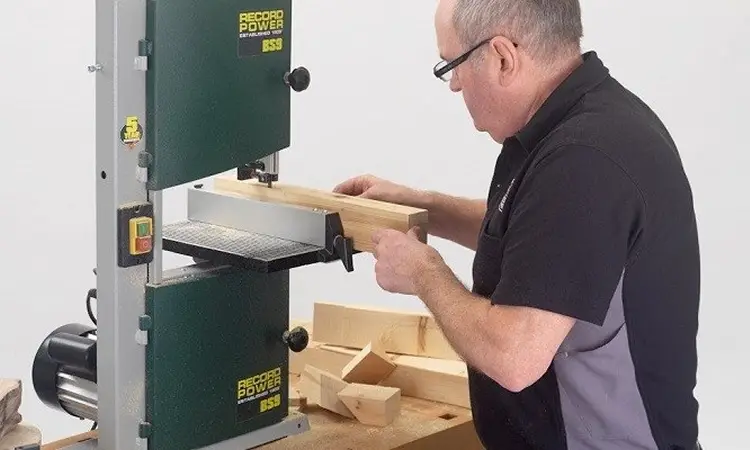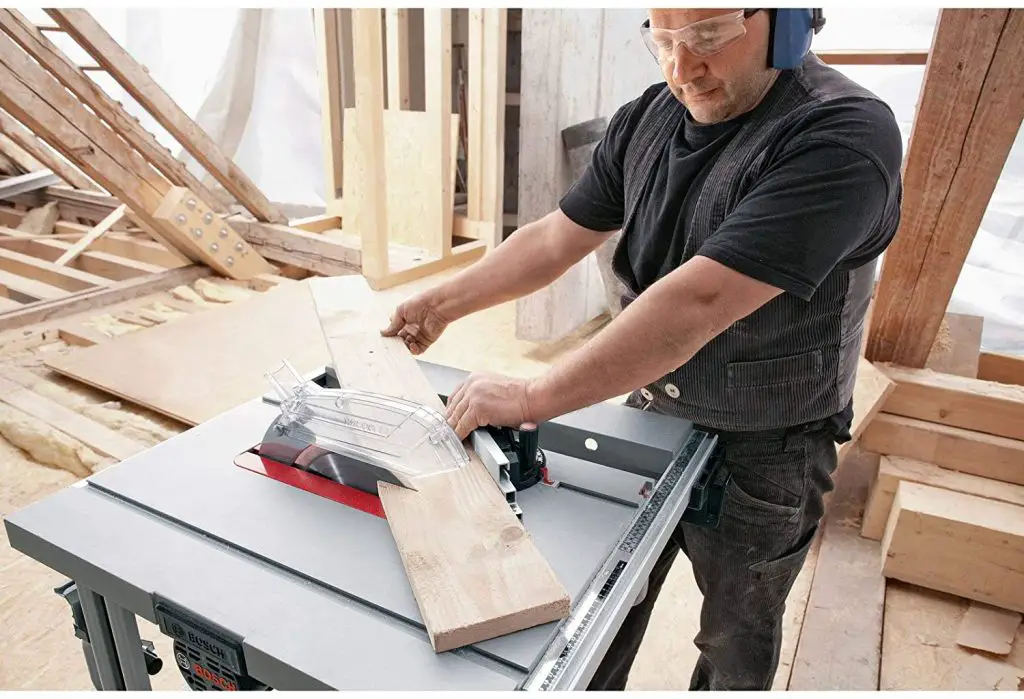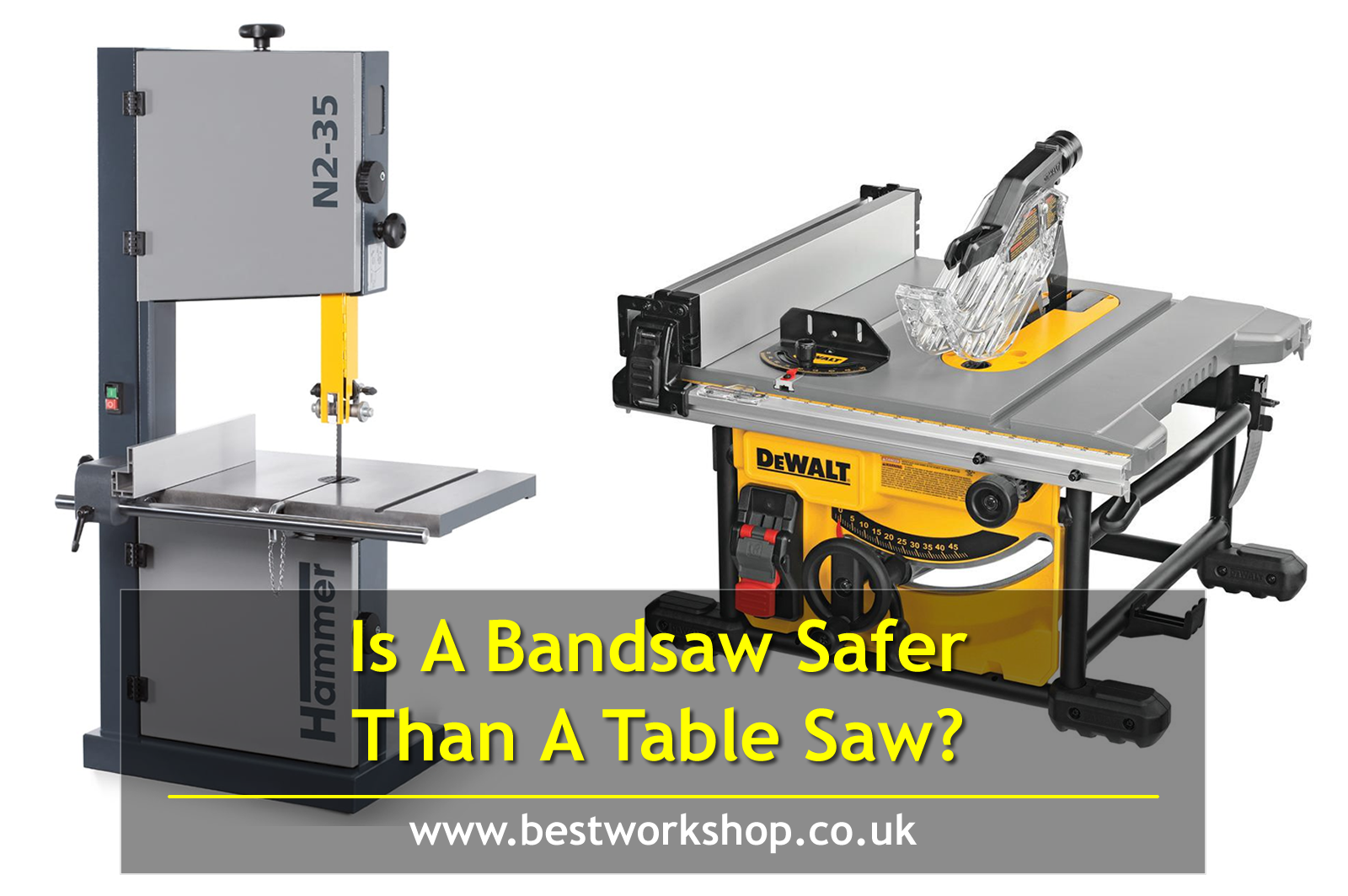Table of Contents
Is a bandsaw safer than a table saw? Bandsaws are the safer option but that doesn’t mean that you can’t use a table saw safely. There is, by design, a higher risk of injury from a table saw and since a bandsaw is just as diverse, a lot of new woodworkers opt for this safer choice.
It doesn’t take me to tell you that any kind of bladed tool like a saw is going to be dangerous in the wrong hands or when it is used incorrectly. I’m a stickler for workshop safety so before we discuss anything else, I have to press the importance of educating yourself on the best practices for using your equipment.
That said, it is common knowledge that some types of saw are considered safer than others. The problem when choosing between saws isn’t so much to do with safety but function. In this guide, I’m going to focus on the differences in safety between the bandsaw and the table saw.
But these are two vastly different pieces of equipment. They’re used in completely different ways for completely different purposes. Therefore, if you’re looking at which would be best for your workshop, the truth is that you’ll probably end up needing both.
In terms of safety, you’ll probably want to know if a bandsaw is safer than a table saw. The answer is yes, a bandsaw is considered to be safer. But again, if you use a table saw correctly then there’s no reason why you should ever encounter an accident. But let’s look at the subject in a little more detail.
What Is A Bandsaw?

A bandsaw is a popular type of power tool used for cutting. The blade is long and thin as is placed between a set of wheels. These tools are incredibly versatile and are not only used for woodworking but for other materials like metal as well.
The great thing about the bandsaw is that the cutting is spread evenly across all of the teeth which makes for a much more consistent result. Moreover, if you’re making a curved cut, your bandsaw will be ideal. It functions in many ways the same as a jigsaw offering similar flexibility. This means that irregular cutting becomes a lot easier.
One important thing to keep in mind when using a bandsaw is that you must ensure you have the correct type of blade according to what you are cutting. But since these saws are so versatile, they’re often considered essential even in a beginner’s workshop. You’ll find them in all settings such as machine shops, woodworking shops and even butchers! Of course, the type of bandsaw you’ll see in these places will vary.
Comparing the bandsaw to the table saw, it’s much safer and I’ll go into the reasons why a little later on but it’s also far superior when it comes to cutting thicker stock or curves.
What Is A Table Saw?

A table saw may go by many other names including the bench saw. Unlike the bandsaw which has a straight blade, the table saw uses a circular blade. This is mounted to the table and is rotated rapidly using an electric motor.
Much like the bandsaw, there are various types of table saw to choose from including hybrid, compact table saws, contractor and cabinet table saws. But in any case, they’re all designed for the same purpose; it’s just that different types have slightly different features that are ideal for certain situations.
When using the table saw, you can adjust the height of the blade according to the material you are working with. They are typically most suited to use with wood although it is possible to use them for other applications. The blade angle can also be altered which is essential in any woodworking shop.
In fact, the table saw is considered such an essential tool for woodworking that you won’t find a workshop that doesn’t have one. Some people believe that a circular saw or mitre saw is best but these have nothing on the table saw and when buying your basic equipment, this is something I’d always suggest investing in.
Why Is A Bandsaw Safer Than A Table Saw?
Any experienced woodworker will tell you that a table saw is far more prone to accidents than, not just the bandsaw, but any other type of saw out there. This shouldn’t put you off using one because, as I keep saying, when you use them according to all of the relevant safety rules, you shouldn’t have too many problems. However, if you were going to have an accident with either of these tools, I’d put money on it that it would be with your table saw.
The thing is that when you use a table saw, your hands end up being a lot closer to the blade. It is ALWAYS recommended to use a push tool rather than your hands to guide the material through the blade, but even then, there’s the risk of slipping. If you don’t use a push tool, those fingers come dangerously closer to the sharp, spinning blade and it doesn’t take me to tell you what the consequences of that could be.
Moreover, the table saw has a much higher risk of sending debris flying at high speeds across the workshop. So, for this reason, you always need to have your wits about you.
On the other hand, the bandsaw is able to keep your material on the table more securely thanks to the design of the blade. Unlike a table saw, the bandsaw blade cuts vertically and is much narrower so many people choose a bandsaw for all types of cut, even those that you might usually choose a table saw for, like rip cuts.
Safe Use Of Band Saws And Table Saws
Despite the bandsaw being safer than the table saw, any piece of equipment that features a powered blade has the potential to be incredibly dangerous. Similarly, when you use the tools correctly and follow some simple yet effective safety guidelines, you should find that you don’t have any problems.
- Regardless of the type of saw you are using, always ensure to wear the correct safety gear. This includes goggles to protect the eyes from flying debris, work gloves and ear defenders. Moreover, you should avoid wearing loose clothing that could become stuck in the blade and take off any jewellery or neckties for the same reason.
- When using a table saw, make sure that the area is kept clean. If there is a lot of sawdust and debris in the way, this could hinder your ability to make safe cuts. Plus, there is a risk of this debris flying up and hitting you or someone else in the workshop.
- If you notice small pieces of debris around your bandsaw, resist the temptation to remove these while the blade is still moving. Turn off the machine, wait for it to stop, cut off the power supply and only then should you clear any debris.
- Never remove safety guards.
- When using a bandsaw, the blade may get stuck when making a curved cut. Do not pull back out of the cut while the blade is still moving. Even better, plan cuts before making them and include exits should the blade jam.
- If you need to change the blade on your bandsaw or table saw, always be sure to disconnect the tool from power.
- When operating a table saw, make sure that you stand correctly with a wide base for added stability.
- For both bandsaw and table saw operations, you should always check the piece of stock for foreign objects such as nails, screws and loose knots. These could be dislodged by the blade and fly off causing an injury.
Conclusion
Table saws and band saws are both important pieces of equipment in any woodworking shop. However, there’s a lot of speculation over which is the safest with many people asking if a bandsaw is safer than a table saw?
In short, bandsaws are the safer option but that doesn’t mean that you can’t use a table saw safely. There is, by design, a higher risk of injury from a table saw and since a bandsaw is just as diverse, a lot of new woodworkers opt for this safer choice.
I’ve included some helpful safety tips in this guide but this is by no means an exhaustive list. If you want to remain free from injuries while using your saws, always employ common sense and never put yourself in a situation that could obviously result in an accident.

